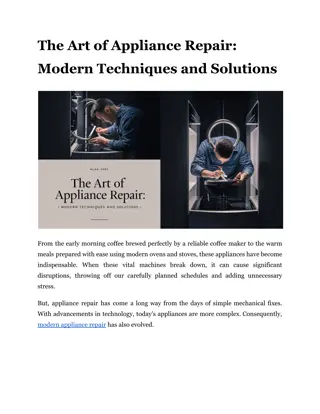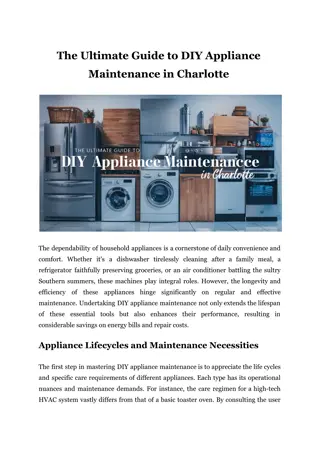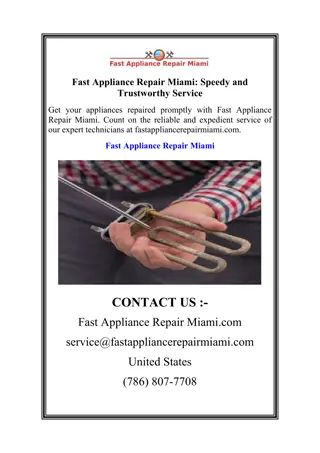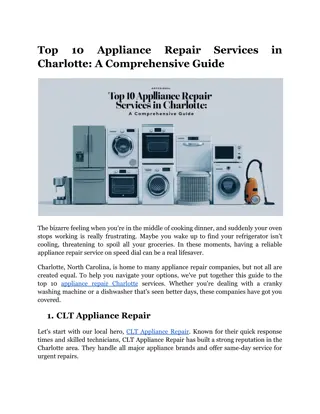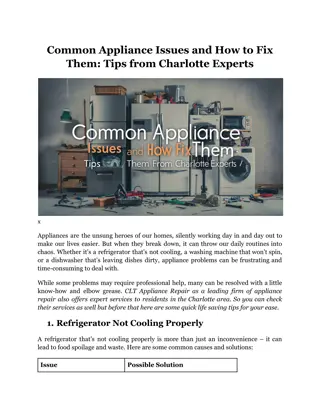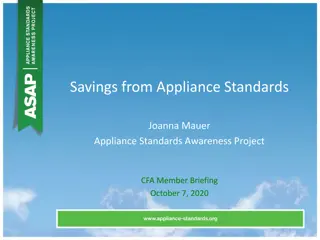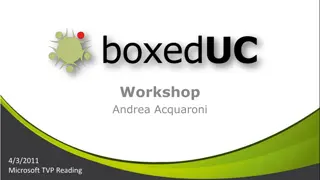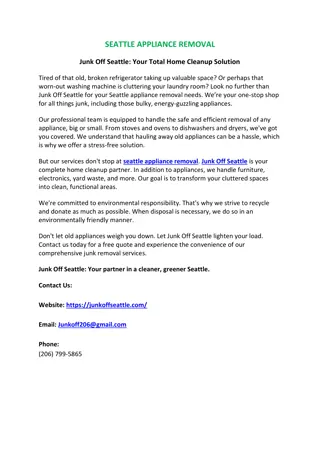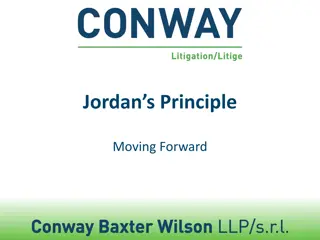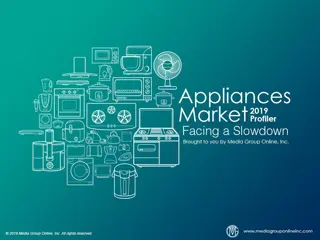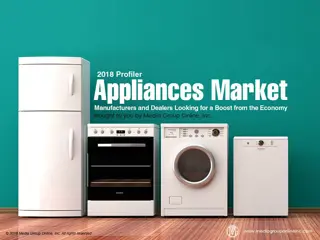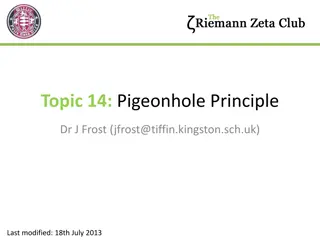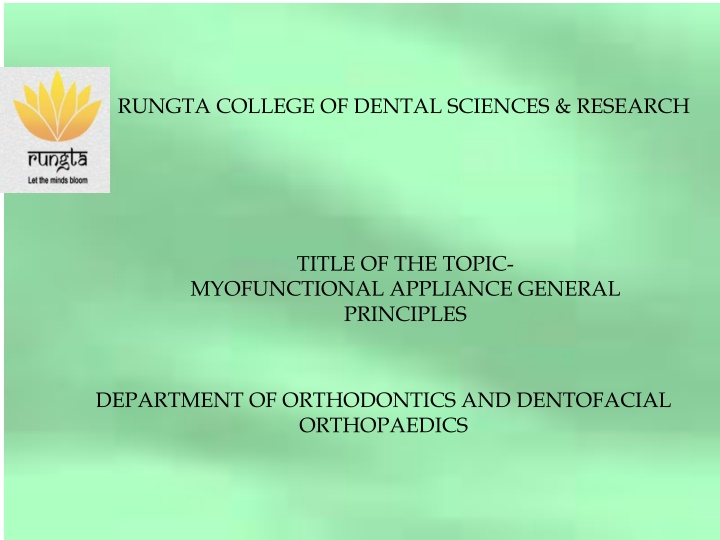
Myofunctional Appliance Principles in Orthodontics and Dentofacial Orthopedics
Explore the general principles of myofunctional appliances in orthodontics and dentofacial orthopedics, including classifications, effects, indications, advantages, and limitations. Learn about the evolution of functional appliances and their impact on jaw positioning and growth modulation.
Download Presentation

Please find below an Image/Link to download the presentation.
The content on the website is provided AS IS for your information and personal use only. It may not be sold, licensed, or shared on other websites without obtaining consent from the author. If you encounter any issues during the download, it is possible that the publisher has removed the file from their server.
You are allowed to download the files provided on this website for personal or commercial use, subject to the condition that they are used lawfully. All files are the property of their respective owners.
The content on the website is provided AS IS for your information and personal use only. It may not be sold, licensed, or shared on other websites without obtaining consent from the author.
E N D
Presentation Transcript
RUNGTA COLLEGE OF DENTAL SCIENCES & RESEARCH TITLE OF THE TOPIC- MYOFUNCTIONAL APPLIANCE GENERAL PRINCIPLES DEPARTMENT OF ORTHODONTICS AND DENTOFACIAL ORTHOPAEDICS
Specific learning Objectives CORE AREAS INTODUCTION CLASSIFIACTIONS PRINCIPLES DOMAIN CATEGORY DESIRE TO KNOW MUST KNOW MUST KNOW AFFECTIVE COGNITIVE COGNITIVE EFFECTS OF FUNCTIONAL APPLIANCES INDICATIONS & ADVANTAGES LIMITATIONS COGNITIVE NICE TO KNOW COGNITIVE MUST KNOW COGNITIVE NICE TO KNOW
CONTENTS INTRODUCTION CLASSIFICATIONS PRINCIPLES EFFECTS OF FUNCTIONAL APPLIANCE INDICATIONS & ADVANTAGES LIMITATIONS
INTRODUCTION Functional appliances are defined as loose fitting or passive appliance, which harness natural forces of the oro-facial musculature that are transmitted to the teeth and alveolar bone through the medium of the appliance. Myo-functional appliances as they are sometimes referred to appliances that depend upon the oro-facial musclature for their action. In earlier days these terms used synonymously.
introduction Definition Proffit functional appliance is one that changes the posture of the mandible, holding it open or open & forward. Pressures created by the stretch of the muscles & soft-tissues are transmitted to the dental & skeletal structures, moving teeth & modifying growth.
evolution 1. NORMAN KINGSLEY : 1879 first to use the forward positioning of the mandible in orthodontic therapy bite Jumping appliance . He used forward positioning of the mandible in orthodontic treatment.
evolution 2. PIERRE ROBIN (1902): Functional device for jaw bone expansion & glossoptosis therapy His appliance- The MONOBLOC influenced muscular activity by changing the spatial relationship of the jaws. 3.VIGGO ANDRESEN(1909): Introduced the activator. Appliance later modified by karl Haupel. The herbst appliance a fixed functional appliance was introduced in 1905 by Emil Herbst.
evolution WILHELM BALTERS in an effort to treat class 2 malocclusion characterized by deficient mandibles, began to modify Andresen s activator. He gave it the name BIONATOR.
evolution ROLF FRANKEL (1957): Designed the functional regulator. The appliance was designated as FR-1, FR-2, and FR-3 for treating class 1, class 2 and class 3 malocclusions.
classification GRABER S CLASSIFICATION GROUP I: Transmit muscle force directly to teeth Ex. Inclined planes Oral shields/screens GROUP II: activating attached & associated musculature Force not only to teeth, also maxilla & mandible Ex. Activator, bionator
classification GROUP III: vestibular positioned appliances with isolated support from tooth/tissue. Ex. Frankel Function Regulator lip bumper.
classification I. MYOTONIC: depend on muscle mass for their action II. MYODYNAMIC: Depend on the muscle mass for their action
classification PROFFIT S CLASSIFICATION I. PASSIVE TOOTH-BORNE APPLIANCES: No intrinsic force generating capacity (screws/springs) Soft-tissue stretch & muscular activity Ex. Activator Bionator Twin Block Herbst appliance
classification II. ACTIVE TOOTH-BORNE APPLIANCES: Include expansion screws/springs to move teeth Activator & modifications bearing active components Ex Expansion activator Orthopedic corrector Sagittal appliance III. TISSUE-BORNE APPLIANCES: Located in vestibule Free of contact with bone/teeth Ex. Function Regulator
classification A. REMOVABLE FUNCTIONAL APPLIANCES B. FIXED FUNCTIONAL APPLIANCES 1. FLEXIBLE FFA Jasper Jumper Amoric Torsion Coils Adjustable Bite Corrector 2. RIGID FFA Herbst appliance Cantilevered Bite Jumper MALU Herbst appliance 3. HYBRID FFA Calibrated Force Module Eureka spring Forsus FRD
principles 2 principles FORCE APPLICATION 1. FORCE ELIMINATION 2.
principles FORCE APPLICATION Compressive stress & strain on structures 1. Primary effect alteration of form Secondary effect adaptation in function Ex. all active fixed & removable appliances
principles FORCE ELIMINATION (Myofunctional) Abnormal & restrictive environmental influences eliminated optimal development 2. Primary effect rehabilitation of function Secondary effect adaptation of form according to function Elimination of pressure by viscoelastic displacement of periosteum tensile strain bone formation Ex. Functional regulator, lip bumper, vestibular screen
principles The success of functional appliance therapy depends on 1. Patient compliance 2. Timing of treatment 3. Neuromuscular response - Poliomyelitis & cerebral palsy
principles 2. DIRECTION: For tooth movement CONSISTENT Functional forces stimulate tooth movement in one direction When appliance not worn forces of intercuspation & occlusion drive teeth in opposite direction JIGGLING Eliminate Does not occur with full-time/bonded appliances 3. MAGNITUDE: Small in functional therapy Difficulty in wearing appliance if strain too great.
effects FORCE APPLICATION TYPE (prototype Activator) Effects on Mandible: 1. Increased amount of condylar growth Remodeling of the articular fossa anterior Incremental increases in growth of mandible Combination of these effects - permanent anterior displacement of the mandible. Condylar growth POSTERIORLY directed DOWNWARD & BACKWARD mandibular rotation
effects 2. Effects on Maxilla: Inhibit horizontal maxillary growth Increase posterior maxillary height 3. Effects on Dentition: Maxillary incisor lingual tipping Mandibular incisor labial tipping Inhibits vertical maxillary dentoalveolar development Encourages vertical mandibular dentoalveolar development
effects 4. Effects on Soft tissue: Upper lip retrusion Anterior positioning of soft-tissue pogonion
effects FORCE ELIMINATION TYPE (prototype prototype Functional Regulator) Functional Regulator) 1. Effects on Mandible: Forward displacement of pogonion & point B. Increase in mandibular length 2. Effects on Maxilla: No horizontal effects on maxilla Downward & backward rotation
effects 3. Effects on Dentition: Lingual tipping of maxillary incisors Prevents mesial migration of upper molars & not extrusion 4. Effects on Soft-tissue: Improvement in lip position No change in convexity of profile 5. Effects on Arch width: Expansion of arch-width more in maxilla
INDICATIONS Expansion & sagittal correction of jaws Treatment timing maxillary incisors more vulnerable to fracture & loss Eliminate functional aberrations Train perioral musculature optimal development Help mandible attain most favorable growth increments & directions Help eliminate arch-length deficiencies normalizing functional matrix & functional spaces Accelerate trend to eliminate abnormal muscle pattern at a critical time 1. 2. 3. 4. 5. 6. 7.
Advantages of functional appliances It enables elimination of abnormal muscle function thereby aiding in normal development. Treatment can be initiated at an early age. It is most often started in the mixed dentition period. As the treatment is started at an early age, psychological disturbances associated with malocclusion can be avoided. These appliances are mostly fabricated at the dental laboratory. Thus less chairside time is spent which enables more patients to be treated.
The frequencyof the patients visit to the orthodontist is less than in case of fixed or removable appliances. They do not interfere with oral hygiene maintenance. Most functional appliances are worn during the night. Thus patient acceptance is good.
Limitations Of Functional Appliances They cannot be used in adult patients in whom growth has ceased. They cannot be used to bring about individual tooth movement. Most functional appliances are dependent on the patient for timely wear. Thus patient cooperation is essential for the success of the treatment. They may require pre-functional orthodontic tooth movement for correction of minor local irregularities that may interfere with the functional therapy. Fixed appliance therapy may be required at the termination of treatment for final detailing of the occlusion.
SUMMARY The ideal requirements of a functional appliance are: It should be comfortable and acceptable for the patients. It should promote better compliance. It should offer good range of mandibular movements. It should be simple and inexpensive. It should be easy to ft. It should be adaptable to both Class II and Class III malocclusions. When used with fixed appliances, it should not cause breakage. It should be usable in both mixed and permanent dentitions. It should provide good results with minimal patient cooperation.
REFERENCES Textbook of Orthodontics Gurkeerat Singh, Jaypee Brothers; 2nd Edition Orthodontics The Art and Science, S.I Bhalajhi, AryaMedi Publishing; 7th Edition Textbook of Orthodontics Sridhar Premkumar, Elsevier; 1st Edition Orthodontics: Diagnosis and Management of Malocclusion and Dentofacial Deformities O.P Kharbanda, Elsevier; 1st Edition



